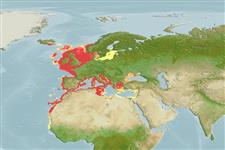Classificação / Names
Common names from other countries
Referência principal
Tamanho / Peso / Idade
Max length : 170 cm TL macho/indeterminado; (Ref. 26999); common length : 125 cm TL macho/indeterminado; (Ref. 244); Idade máx. registada: 19 anos (Ref. 72467)
Length at first maturity
Lm ?, range 77 - 79 cm
Ambiente
; marinhas associadas(os) a recifes; intervalo de profundidade 1 - 400 m (Ref. 27000), usually 20 - 63 m (Ref. 244)
Clima / Intervalo
Subtropical, preferred 15°C (Ref. 107945); 64°N - 12°N, 18°W - 36°E
Distribuição
Northeast Atlantic: Shetlands (rare), southern Scandinavia and British Isles to Morocco, including the Mediterranean. Distribution southward of this range is uncertain.
Países | Áreas FAO | Ecossistemas | Ocorrências | Introduções
Descrição breve
Espinhos dorsais (total): 0; Raios dorsais moles (total): 0; Espinhos anais 0; Raios anais moles: 0. A large, fairly stocky, catshark with large and small black spots and sometimes white spots covering dorsal surface, saddle markings obsolete, small anterior nasal flaps that do not reach the mouth, no nasoral grooves, labial furrows on lower jaw only, second dorsal fin much smaller than first (Ref. 244)
Categoria na Lista Vermelha da IUCN (Ref. 115185)
Ameaça para o homem
Harmless
Utilização humana
Pescarias: pouco comercial; Aquário: Aquários públicos
Mais informação
ReferênciasAquaculturaPerfil para aquaculturaEstirpesGenéticaFrequência dos alelosHereditariedadeDoençasProcessamentoMass conversion
Ferramentas
Relatórios especiais
Descarregue XML
Fontes da internet
Estimates of some properties based on models
Phylogenetic diversity index
PD50 = 0.5000 many relatives (e.g. carps) 0.5 - 2.0 few relatives (e.g. lungfishes)
Nível Trófico
4.0 ±0.3 se; Based on diet studies.
Resiliência
Baixo, tempo mínimo de duplicação da população 4,5 - 14 anos (Fec assumed to be <100)
Vulnerabilidade
High to very high vulnerability (67 of 100)
Categoria de preço
